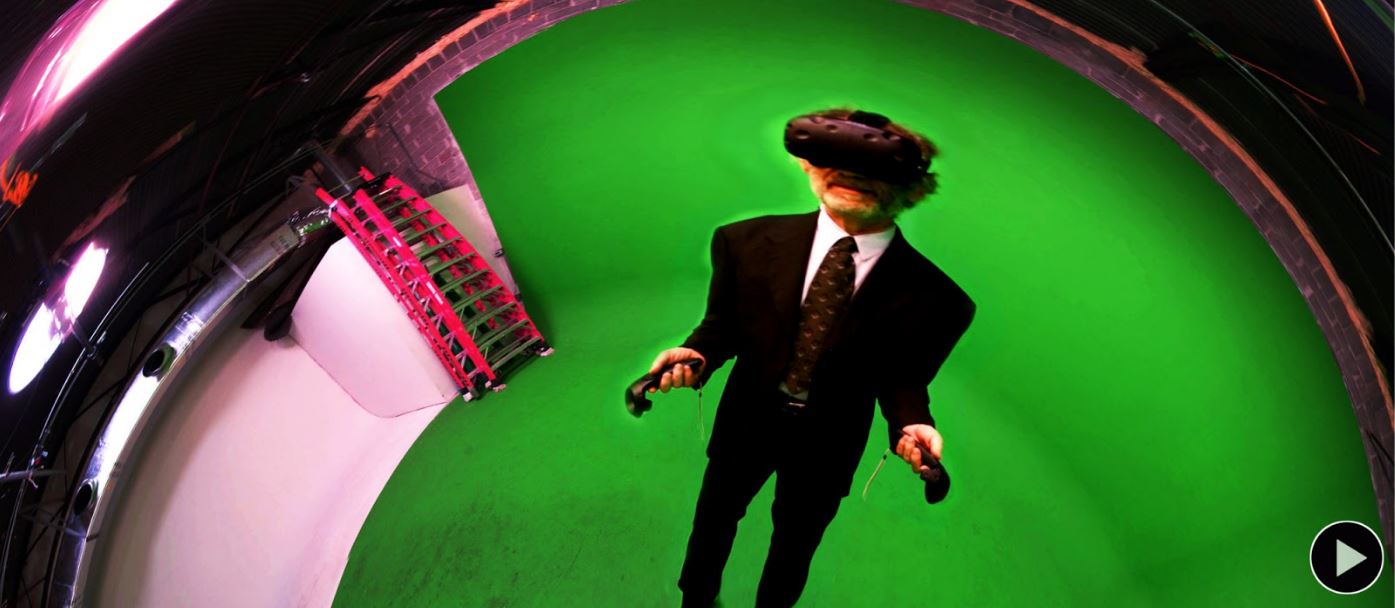You feel like you’re there. That’s the power of immersion.

Immersive technologies hijack your senses to persuade them that you are now within the virtual environment.
When it works, you are promoted from mere observer to full inhabitant of this new world.
We visit worlds beyond our reach: remote locations, ancient times, worlds of fiction and every sort of fantasy. We visit with superpowers like X-ray vision or bullet time. We enter as lucid dreamers: thanks to immersive technology, our “willing suspension of disbelief” requires very little will power.
The goal of immersion isn’t new. Renaissance painters achieved it by inventing perspective. Audiophiles pursue it by piling up speakers. Early movies, grainy, jumpy and silent, were stunningly immersive to their new audiences. People ran screaming from the theater when an oncoming locomotive was projected on the screen.
Today we seek immersion in the new medium of virtual reality. In Georgia, many teams are exploring this brave new world. Some are creating entertainment; others build exhibits or online promotions. Many want to use its power for training or education or self-improvement. Some of the leading researchers in virtual reality psychotherapy have been working in Tucker, Georgia for decades. I’ve been lucky enough to meet most of these explorers and collaborate with many of them.
Virtual reality means different things to different people, ranging from classic stereoscopic viewers to large-scale, whole-body VR systems. At each level, with hooded eyes and covered ears, immersion is deeper because more senses are engaged and the viewer becomes more of a participant; we take a giant step into immersion just by blocking out the competing signals of real reality. Each level demands more sophistication from its developers. Let’s look at twelve features that promote immersion.
1: STEREO VISION
When each eye sees a slightly different view of the world, depth perception kicks in. This phenomenon of binocular vision has been exploited since the Victorian era. It sucked up pennies in 1900’s peepshow arcades and it will sell 3D movie tickets tonight. Headset-based virtual reality almost always exploits stereo vision…and sometimes little more.
2: 360 VISION
When the image contains everything that can be seen from a single point, it is called 360 (pano, photosphere, surround photo). You are the center of the scene. As in real life, you see only one sector of the scene at any time, but you can pan and tilt the view to see whatever part you like. If you’ve used Google Street View, you are familiar with 360 vision.
3: HEADTRACKING
Everybody can enjoy a 360 image. On a flat screen, you change the angle of view with mouse or fingertip. Virtual reality systems, however, introduce the new feature of head tracking. To select the angle of view, just turn to face what you want to see. This direct, natural control of the field of view enhances immersion. It is associated with headsets, but it can also be achieved with a bare cell phone. As you turn your head, you keep the cell phone screen in front of your face–offering a moving window into the virtual world.
4: 360 VIDEO
The 360 image can be a video. In this case, the world contains moving images and the location of the point of view the camera location) may also be moving. Camera motion is baked into the video. While viewing, you cannot control the camera location; you control its angle and tilt. Of course, nothing’s free. This huge volume of video demands a lot of bandwidth and storage.
5: 360 AUDIO
The sense of immersion is significantly enhanced by the addition of audio, particularly when the audio sources are located in space and change as the field of view rotates. Audio production is far less expensive than producing visuals, yet it can be even more compellingly immersive.
6: CGI
The virtual world becomes far more fluid when it is live, rather than pre-recorded. You view fresh computer-generated imagery, rather than static photography. This is rendered in real time, as in a video game. Now (if your headset supports it) you can not only change the angle of view but also shift the location of your head to see around objects in the foreground. This effect, parallax, is a strong contributor to visual immersion. With 3D CGI, the system is driven by computation rather than on pumping pixels. You can enjoy high resolution without big data demands.
3D content also includes the hybrid technology of photogrammetry. In photogrammetry, the synthetic world is not an artist’s model, but instead the result of scanning a real scene and its contents. Photogrammetry offers a moving point of view and parallax. But because it is ultimately pixel-driven, its bandwidth savings are limited and it does not easily support high resolution close-ups.
7: DYNAMICS
3D content means that not only can you change your point of view, but also the live computer generated world can come alive with action. 3D animation requires up-front effort but then needs little data to bring characters and objects to life in the virtual world. Animation can be simple scripted movement or complex algorithmic behavior. There are really no limits to dynamic content.

8: REALITY
Your virtual world might incorporate a live view of your real world. Now you are in “mixed reality.” This category includes augmented reality, where the system embeds virtual images into the world around you, either by intercepting the video feed of a camera or by reflecting into the view you see through your glasses.
It also includes a type of augmented virtuality, in which bits of your real time world can be seen embedded in the
computer-generated scene. In augmented reality, you control not only the angle of the camera, but also its location. A geolocated application, using GPS for example, can respond to location cues all over the world. Think Pokémon GO.
Hardcore immersive overachievers are not satisfied with mixed reality. They want transreality. Mixed reality combines the “virtual” and “real” into a single experience. Transreality combines multiple experiences (real, virtual and alternate) into one complex thread.
9: LOCOMOTION
High precision location becomes possible when GPS satellites are replaced by local landmarks, such as the tiny electronic beacons called lighthouses or base stations. Virtual reality systems with this technology allow you to walk around, stand up or crouch to see new things. This freedom of movement adds extraordinary verisimilitude to the virtual scene. Exploring on foot, rather than sitting, means you are far more present in the virtual space. Different systems offer different volumes: HTC’s mass-market Vive operates at room scale; custom built systems can offer warehouse-scale play. Walking in a tightly registered virtual space makes it feel rock solid. But systems without this positioning technology often attempt virtual locomotion. You move in the virtual world, but your real body goes nowhere. The dissonance between visual cues of movement and the body’s sense of stasis frequently results in nausea.
10: AGENCY
Not only can you look around, but you can be an agent of change. The live computer generated world can respond to your actions. It can respond to what you are looking at. When you walk, objects can respond to your proximity. You are not just present; you are participating. As you move, you enjoy the consequences of your action. A world that responds to you offers profound immersion.
11: MANIPULATION
A system that can precisely track your head, can (with more hardware) also track other things. In particular, it can track your hands. The virtual world becomes more immersive as you reach out to touch it. Handheld controllers also add haptic experience, immersing another sense in the virtual world.
When you touch the world, you change the world. The virtual world can respond to your direct actions: throwing
an object, wielding a weapon, or opening a door.
12: CHALLENGE
It is not enough to be present. It is not enough to be a participant. A deeper immersion comes when you are motivated to achieve a goal in the virtual world. You will be fully immersed when you are in a world that presents challenges and you confront these to achieve an end. Your goal in the virtual world may be entirely fictitious and self-contained (e.g., you save the castle from attackers) or it can relate to back to challenges you face in real life. In our studio, we like to close the loop. We want players in the world of virtual reality to return with new skills and insights that improve their experience of regular reality. These skills might include hygiene, first responder
skills, social skills and others.


Share this Post




